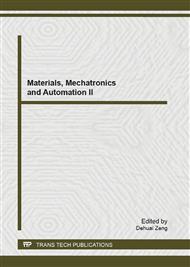p.597
p.603
p.608
p.612
p.618
p.624
p.630
p.636
p.640
Soft Magnetic Material Testing Using Magnetic Resonance Imaging
Abstract:
Soft magnetic field samples were placed into the homogenous magnetic field of an imager based on nuclear magnetic resonance. Several samples made of a soft magnetic material (cut from a data disc) were tested. Theoretical computations on a magnetic double layer were performed. For experimental verification an MRI 0.178 Testa ESAOTE Opera imager was used. For our experiments a homogeneous circular holder (reference medium) - a container filled with doped water - was designed. The resultant image corresponds to the magnetic field variations in the vicinity of the samples. For data detection classical gradient-echo and spin-echo imaging methods, susceptible to magnetic field inhomogeneities, were used. Experiments proved that the proposed method is perspective for soft magnetic material testing using magnetic resonance imaging methods (MRI).
Info:
Periodical:
Pages:
618-623
Citation:
Online since:
August 2013
Authors:
Price:
Сopyright:
© 2013 Trans Tech Publications Ltd. All Rights Reserved
Share:
Citation:


